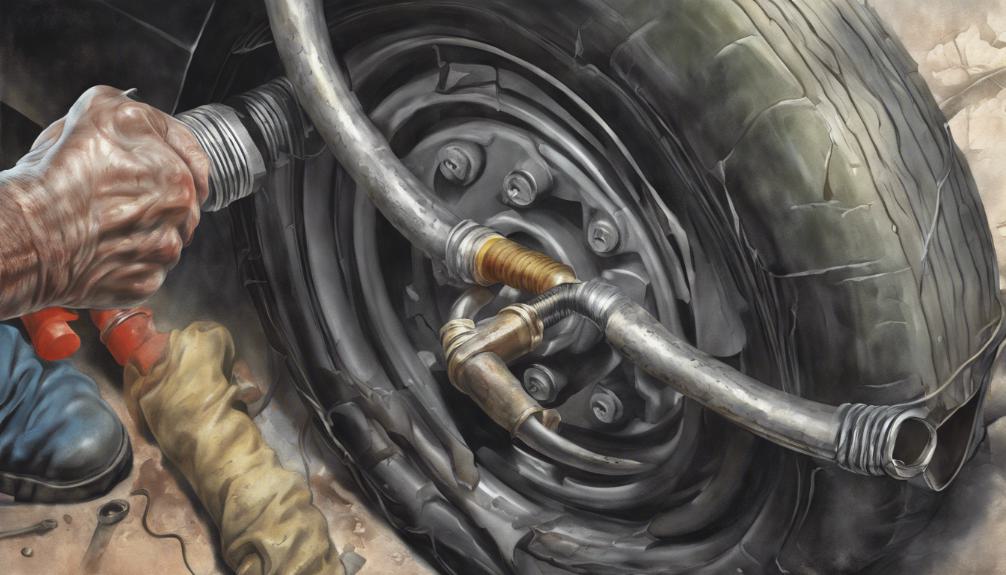If you've noticed a burning oil smell, difficulty steering, or red/light brown fluid under your hood, you might be facing power steering hose leak symptoms. Take action swiftly to prevent further damage. When fluid spurts under the hood, a hose leak is likely—inspect for damage and contain leaks to avoid mess. Opt for temporary repair using hose clamps, a cost-effective solution. For a permanent fix, make sure the engine is off, and choose a compatible hose material. Early detection and maintenance are key for safety and cost-effectiveness. Timely repairs can save you from pricier issues later. Learn more about recognizing and resolving power steering hose leak symptoms.
Key Takeaways
- Look for burning oil smell and difficulty steering.
- Check for red or light brown fluid under the hood.
- Address potential fire risk and high-pressure fluid involvement.
- Use hose clamps for temporary repair.
- Consider professional installation for permanent replacement.
Common Symptoms of Power Steering Hose Leak

If you notice a burning oil smell and find it difficult to steer your vehicle, these are common signs indicating a power steering hose leak. The fluid color associated with power steering fluid is usually red or light brown. It's important to address a power steering hose leak promptly not only for the health of your vehicle but also for your safety. Driving with a power steering hose leak can lead to a potential fire risk due to the high-pressure fluid involved. Ensuring the integrity of your power steering system is vital for vehicle safety.
When the power steering hose is leaking, the fluid can spurt out under the hood, creating a hazardous situation. If you observe fluid spurting under the hood, it's essential to address the issue immediately to prevent further damage and maintain your safety on the road. Monitoring the fluid color and taking action promptly can help maintain your vehicle's safety and performance.
Observing Fluid Spurting Under Hood
When you see fluid spurting under the hood, it signals a power steering hose leak requiring immediate attention to prevent further hazards. The high pressure fluid escaping from the hose can lead to the spraying of fluid, potentially causing a messy and dangerous situation.
Along with the visible fluid, you may also notice a burning oil smell, which is a clear indicator of a hose leak. To address this issue, start by inspecting the power steering hoses for any signs of damage or wear. It's important to contain the leaking fluid to prevent it from spreading and causing additional damage.
Driving with a power steering hose leak is unsafe and can lead to steering difficulties, making prompt repair essential. To avoid potential fire hazards and further complications, it's best to address power steering hose leaks promptly.
Temporary Repair With Hose Clamps

Wondering how to quickly address a power steering hose leak? A cost-effective solution is performing a temporary repair with hose clamps.
This quick fix involves cutting the damaged hose section and using two hose clamps on each side to connect the ends securely. After completing the repair, remember to refill the power steering fluid to guarantee proper lubrication and functionality.
To confirm the effectiveness of the temporary hose clamp solution, start the engine and test for leaks. While temporary repairs with hose clamps can provide a short-term solution, it's essential to note that permanent replacement of the power steering hose is recommended for long-term reliability and safety.
Temporary repairs are a practical way to address the issue promptly and at a lower cost, but for sustained performance, consider replacing the hose permanently.
Permanent Replacement Procedure
To start the essential replacement procedure for a power steering hose leak, make sure the engine is shut off and the power steering fluid has been drained into a pan. When selecting a replacement hose, consider the material options available such as rubber, steel, or Teflon, ensuring compatibility with your vehicle's specifications.
DIY enthusiasts can opt to replace the hose themselves by following the steps of removing fittings at the pump and steering gear to access and replace the power steering hose. It's vital to install the new hose securely, making sure it's correctly attached to the chassis to prevent leaks or damage.
Alternatively, for those less experienced or uncomfortable with automotive repairs, seeking professional installation guarantees a precise and reliable replacement. Once the new hose is in place, refill the power steering pump with fluid to the recommended level.
Importance of Early Detection and Maintenance

Detecting power steering hose leaks early is essential for maintaining the safety and functionality of your vehicle's steering system. By recognizing the signs and addressing them promptly, you can prevent more significant issues from arising. Here are some key points to keep in mind:
- Preventive measures: Regularly check your power steering fluid levels and inspect the hoses for any signs of wear or damage.
- Inspection tips: Look for leaks, cracks, or bulges in the hoses, especially near connection points or bends.
- Early intervention: Addressing minor leaks early can prevent them from escalating into more severe problems that could impact your steering performance.
- Cost-effective solution: Timely detection and repair of power steering hose leaks can save you from costly repairs down the line.
- Safety first: Ensuring the proper functioning of your power steering system is vital for safe driving and vehicle control.
As an Amazon Associate we earn from qualifying purchases.










